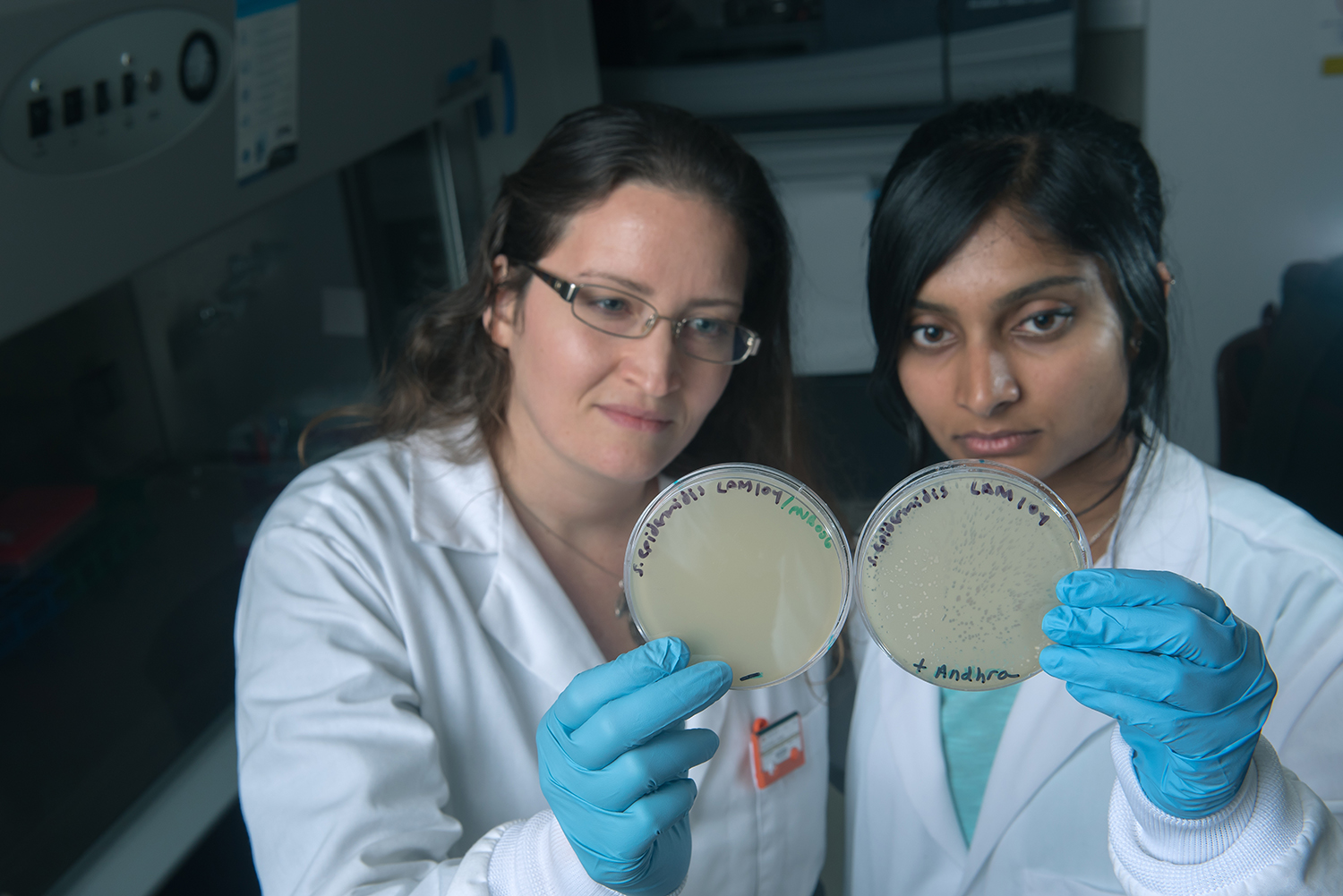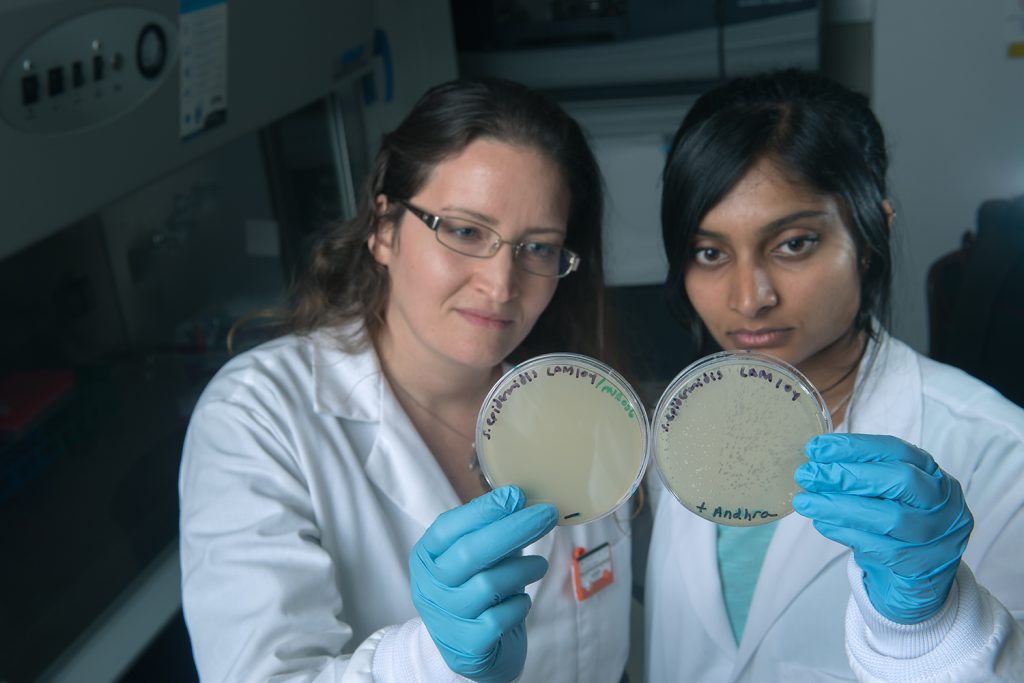
Scientists research ‘perpetual war’ among viruses, bacteria in search of antibiotic alternative
Don’t let her size fool you. Andhra can rock your world … if you’re bacteria.
Though 1,000 times smaller than a human hair’s width, Andhra, and others like her, could prove vital as researchers seek new approaches in fighting antibiotic-resistant bacteria.
First identified by University of Alabama researchers in 2015, Andhra is a virus. Not all viruses are created equal. Sure, some are nasty visitors, triggering a variety of illnesses from chickenpox and the flu to Ebola and AIDS. But, there’s another side to the discussion.
“Not all viruses are bad,” says Dr. Asma Hatoum-Aslan, a UA microbiologist. “There are many viruses out there that specifically attack bacteria. We are particularly interested in understanding the strategies they use to kill bacteria to our own advantage and harness them as alternatives to conventional antibiotics.”
Take, for instance, what happens when Andhra meets a type of bacteria called Staphylococcus, or staph for short.
“With just 20 genes, a startlingly small number, she can infect a staph cell and burst out of it after making about 10 copies of herself within 30 minutes or so,” Hatoum-Aslan said.
PERSONALIZING MEDICINE
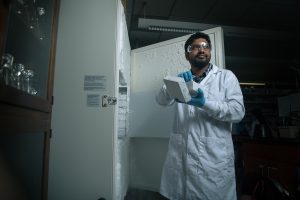
It’s this replication process and the microscopic battles that surround it that researchers seek to understand and exploit.
Viruses like Andhra that are known to attack bacteria are called bacteriophages – phages for short.
In the UA lab, Hatoum-Aslan and those who work with her, along with collaborators at The Center for Phage Technology at Texas A&M University, seek to identify and better understand newly discovered phages as well as the high-tech defense mechanisms bacteria use to fight off invading viruses.
They are also researching the countermeasures phages employ in penetrating those defenses.
This “phage-host arms race,” as researchers label it, is every bit as complex as the Cold War tensions the term brings to mind. But, this war has always been hot – its battles are fought every second of every day – and it will likely continue until the end of life on Earth. The UA scientist calls it a “perpetual war that stirs the genetic soup of life” at the microscopic level.
If researchers can prove both its efficacy and safety, phage therapy could become an accepted alternative to antibiotics in the U.S.
“It really is about personalized medicine,” Hatoum-Aslan says. “Not every infection is the same. At first you have to identify the infectious agent and then identify the type of phage that can attack it.”
NOT NEW, BUT STILL SOME UNKNOWNS
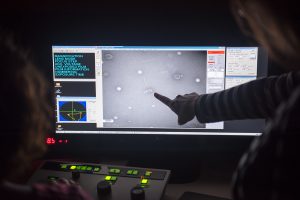
The concept of phage therapy has been around for nearly a century – since the discovery of phages themselves. But, before widespread acceptance and FDA approval is granted in the U.S., these microscopic warriors must be better understood.
A thorough understanding could alleviate safety concerns, regulatory constraints and manufacturing challenges associated with implementing whole-phage therapeutics.
“An important issue, in my opinion, is more than half of their genes have unknown functions,” Hatoum-Aslan says. “One can imagine any number of scenarios in which unknown genes can have unexpected side-effects.
“Ideally, we would like to engineer therapeutic phages that are 100 percent defined, so that we know every gene in that phage, and we know exactly what it does. We are developing the tools to achieve that goal,” Hatoum-Aslan says.
SWITCHING FROM DEFENSE TO OFFENSE
Researchers, like Hatoum-Aslan, are engineering genes in the phages to give them the desired characteristics while removing unwanted or poorly understood genes.
Bacteria are not defenseless against phages, and scientists are interested in exploiting one of those defense mechanisms, called CRISPR-Cas.
“CRISPR-Cas is a powerful defense system bacteria have in their arsenal that could sabotage efforts to use phages to treat infections,” says Hatoum-Aslan.
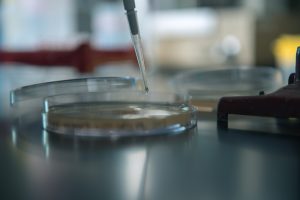
When bacteria with a CRISPR-Cas system are exposed to a virus, the system captures a small strand of the virus’ DNA … and waits for the next encounter. The bacteria transform the stored DNA into RNA that is fed into one or more CRISPR enzymes. These enzymes work like molecular scissors on a search-and destroy mission. They surveil the inside of the cell, waiting for the next invader.
Carrying the minute piece of the RNA for comparison, sort of like a fingerprint for a previously convicted criminal, the scissors look for matching DNA within its microscopic rival. If it finds a match, the scissors slice out the invading DNA, destroying the phage.
“Here’s an interesting twist … now that we know how these systems work, we can program a CRISPR system to recognize and destroy specific bacteria,” Hatoum-Aslan says. “We can essentially turn what was once a defensive mechanism into an offensive mechanism – a way to kill invasive bacteria.”
Scientists are learning how to equip phages with their own CRISPR systems. By replacing that segment of RNA on the scissors with the RNA that matches targeted bacteria, scientists enable phages to seek and destroy specific bacteria.
ONE OF FEWER THAN 10
Most who study these defense systems focus on a type called CRISPR-Cas9. Hatoum-Aslan estimates her team is one of fewer than 10 worldwide who focus on a more complex system, known as CRISPR-Cas10.
In the lab, the UA team has created CRISPR-Cas10 genome editing tools particularly useful for interrogating the functions of unknown phage genes.
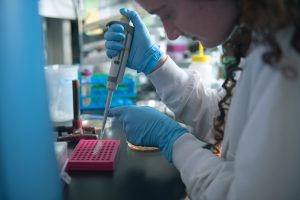
Since their initial find, the UA scientists have discovered 15 additional phages with unique characteristics and hundreds of new genes to probe and characterize.
The UA researchers use Staphylococcus epidermidis as an experimental model. While largely beneficial, these bacteria can become resistant to antibiotics and can pose problems in surgical environments.
Another species, Staphylococcus aureus, naturally resides, mostly without issue, on more than a quarter of the human population, the UA scientist says. It’s this second form of staph most frequently noted for causing serious infections.
As the medical community’s battles against staph and other antibiotic-resistant bacteria build, it’s becoming increasingly evident new counter approaches are needed, Hatoum-Aslan says.
“It’s a global problem. We need to start thinking about alternative strategies,” she said.
Thankfully, viruses such as Andhra, began developing battle strategies long ago and have continued refining their fighting techniques. And researchers such as Hatoum-Aslan continue exploring the “perpetual war” underway on microscopic battlefields worldwide.
Dr. Hatoum-Aslan is a UA assistant professor of biological sciences with funding for this research from the National Institutes of Allergy and Infectious Disease. She recently co-authored two articles on this research, which appear in mSphere and ACS Synthetic Biology.
